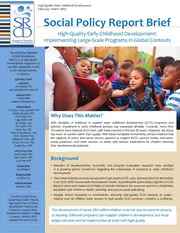Table Of ContentHigh-Quality Early Childhood Development
February / March 2018
Social Policy Report Brief
High-Quality Early Childhood Development:
Implementing Large-Scale Programs in Global Contexts
The Society for Research
in Child Development
(SRCD) is an international,
interdisciplinary organization of
scientists, established in 1933
by the National Academy
of Sciences.
EDITORIAL TEAM
Lead Editor
Ellen Wartella, PhD
[email protected]
Assistant Editor
Fashina Aladé
[email protected]
Editorial Board
P. Lindsay Chase-Lansdale, PhD
Sandra Waxman, PhD
Why Does This Matter?
David Figlio, PhD
Craig Garfield, MD
Neil Jordan, PhD With decades of evidence to support early childhood development (ECD) programs and
Terri Sabol, PhD policies, investment in early childhood policies has expanded globally. Currently, more than
David Uttal, PhD 70 nations have national ECD laws, with most enacted in the last 20 years. However, the focus
Diane Schanzenbach, PhD
has been on access rather than quality. With these increased investments comes evidence that
Dedre Gentner, PhD
the capacity of policy and social service systems to support ECD—across health, education,
Matthew M. Davis, MD
Amelie Petitclerc, PhD social protection, and other sectors—is weak, with serious implications for children reaching
Rachel Flynn, PhD their developmental potential.
SRCD Policy Staff
Martha Zaslow, PhD
Patricia Barton, MPP Background
Lauren Nemeroff
Science Writer • Decades of developmental, economic, and program evaluation research have resulted
Anne Bridgman in a growing global consensus regarding the importance of investing in early childhood
development.
Managing Editor
Lisa Braverman • The United Nations recently incorporated high-quality ECD, care, and education for all children
in its 2015-2030 Sustainable Development Goals, expanding the global policy agenda in ECD
Editorial Assistant
Stephanie Custer beyond infant and maternal mortality to include indicators for universal access to preprimary
education and children’s health, learning, and psychosocial well-being.
• Despite recent increases in investments, ensuring high-quality ECD services at scale—
The brief summarizes the
making sure all children have access to high-quality ECD services—remains a challenge.
Social Policy Report, “Toward
High-Quality Early Childhood
Development Programs and
Policies at a National Scale: The development of about 250 million children is at risk due to extreme poverty
Directions for Research in Global
or stunting. Effective programs can support children’s development, but must
Contexts,” February 2018
available from www.srcd.org. target risk level and be implemented at scale with high quality.
Background (continued)
Two facets of scaling must be addressed: how to build high-quality systems to support large-scale service provisions in places
where such systems don’t exist, and how to change behavior across existing systems to improve quality.
• These aspects require new approaches to scaling, as both are complex.
• Two ways to work toward achieving high-quality programs at scale are: a small to bigger approach that includes bringing
high-quality small-scale pilot initiatives to scale and expanding them to broader populations, and a big-to-better approach for
programs that are at scale but require improvement.
What the Research Says Implications for Policy and Practice
When considering improving quality while maximizing As nations invest in early childhood services, they should
access, it is necessary to focus not just on the classroom or monitor systems-level factors. This means moving beyond
program but also on systems at the local, subnational, and simply authorizing spending to creating indicators of
national levels. The ECD field has a small, growing body of implementation quality at scale. Efforts to accurately record
systems-level research to inform implementing integrated and track quality data should occur at multiple levels and
high-quality services at national scale. Issues that need to across sectors. For example:
be addressed include:
National Level
• A national plan, including a budget for services across
• Multisectoral coordination: Unlike single-sector goals,
sectors, standards for quality of services in each sector, and
maximizing developmental potential from the prenatal
a strategy to monitor access and quality
period to age 8 involves coordinating policies and
programs across health, nutrition, education, social
• A coordinating body that convenes regularly with
protection, and child-protection sectors.
representation from different sectors
• A focus on quality at the systems level: Despite agreement
• A national data system to track budgeting, access, and
that quality across different government systems should
quality across the geographic, political, and culturally diverse
be prioritized when scaling ECD programs, few systems
contexts of the country
are intentionally designed to support and monitor quality;
most are oriented toward access. Subnational Level
• Definitions for competencies specific to each sector’s
• Population-level demand: Demand for specific services
workforce
may be low and varied for ECD programs and policies
that, while effective, are unfamiliar to families (e.g., home • Systems for training, onsite coaching, and supervision that
visiting). addresses these competencies
• Developmentally informed sequences of services and • Data that flow from subnational to national levels and back
programs: The rapid and significant changes that occur to identify and address gaps in access and quality
in the early years of development require programs and
services that differentiate young children of varying ages Municipal or Local Level
• Monitoring preservice and inservice training in each sector
and also consider transitions.
locally to assure training supports positive family and
developmental outcomes
• Monitoring daily responsibilities, routines, and behaviors
in the early childhood workforce to assure alignment with
quality standards
This brief summarizes a longer Social Policy Report by Hirokazu Yoshikawa, University Professor and Co-Director,
Global TIES for Children Center, New York University; Alice J. Wuermli, Associate Director, Global TIES for Children
Center, New York University; Abbie Raikes, Associate Professor of Early Childhood Development and Public Health, Visit
University of Nebraska; Sharon Kim, Research Affiliate, Global TIES for Children Center, New York University; and
www.srcd.org
Sarah B. Kabay, Doctoral Candidate, International Education, New York University. This report is a product of the
2016 meeting, Evidence for Scale: Research Methods to Support the Implementation of Quality Education and Early for more child development
Childhood Development Programs at Large Scale in Global Contexts, held at New York University Abu Dhabi Institute.
materials.
View the full Social Policy Report at www.srcd.org.
© Society for Research in Child Development, 2018.

